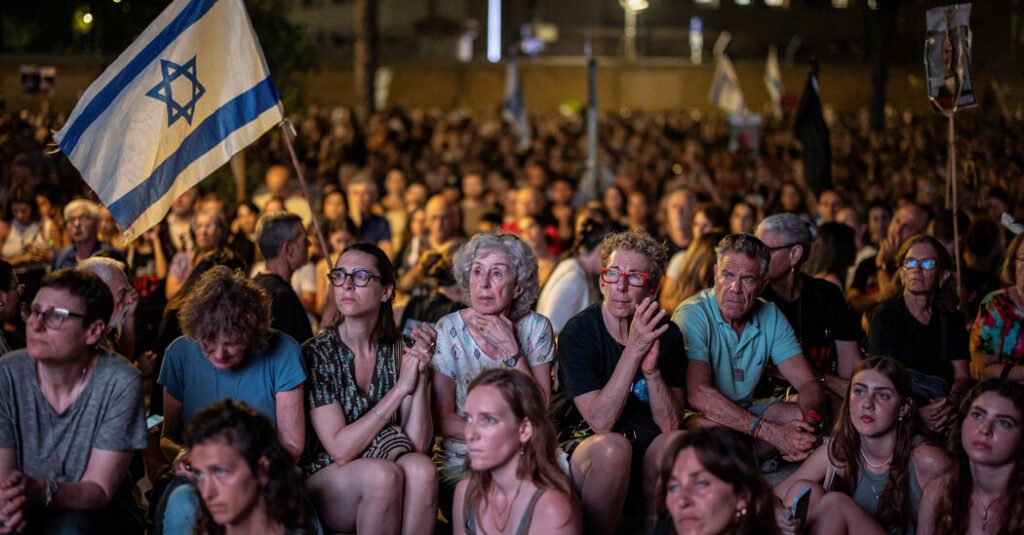Heavy air strikes and ground operations by Israeli forces on Saturday to rescue four hostages in the central Gaza town of Nuseirat killed more than 200 people, two hospital officials in the area said.
Residents said it was the deadliest attack they could remember in the eight-month war. A hospital official said Israeli forces had struck a busy market, and footage from the aftermath showed bloody bodies lying in what appeared to be the marketplace.
Other video footage showed people running for cover as a powerful airstrike exploded nearby.
Dr. Khalil Dakran, spokesman for Al-Aqsa Martyrs Hospital near Deir al-Balah, and Marwan Abu Nasser, deputy director of Al-Awda Hospital in Nuseirat, said their hospitals had received a combined total of more than 200 dead and many wounded in Saturday’s attack. Hospital officials said many of the victims were women and children.
Israeli military spokesman Maj. Gen. Daniel Hagari estimated the casualty to be fewer than 100, but did not say whether they were dead, wounded or both.
The New York Times could not independently verify the death toll, and it is unclear how many were civilians and how many were Hamas fighters.
Dr Daclan said several hours later some of the dead had already been buried by their families, but others were still unclaimed.
“The martyrs whose identities have yet to be determined are still in the morgue. It is difficult to identify them,” he said. “Some of the martyrs who have arrived have only the torn limbs of children, women and old people, so it is difficult to identify them.”
Tens of thousands of Palestinians have fled to Nuseirat in recent weeks to escape Israeli bombardment in other parts of the embattled Gaza Strip, including the southern city of Rafah, where Israel recently launched a new offensive.
Khaled al-Saadouni, a young man who witnessed the Israeli operation in Nuseirat, told Reuters he saw Israeli special forces arriving in Apache attack helicopters and also saw white cars carrying Israeli troops.
“The Apaches started bombing and firing directly at people,” he said, according to Reuters, adding that there were many casualties. “People fled,” he said.
He said many displaced Palestinians were taking refuge in the areas that were attacked.
“We took 10 wounded people in one ambulance, one of whom had been shot. We barely managed to get out of the alley,” he said.
Kitam Awad, a 35-year-old teacher, said she was teaching 25 young students and distributing gifts at her home when the Israeli military offensive began nearby.
“We were near the site of the bombing,” she told The New York Times. “I don’t know how we escaped unscathed.”
She added that the attack lasted for two hours in a “mad manner” and prevented them from moving from their homes. One of her colleagues, a teacher, later learned that two of her relatives had been killed. She said they had been huddled in one room with their students while surrounding houses were being attacked.
“We could hear the tanks,” Awad said. “We were on edge, we didn’t know what was going on around us with the bombs and rockets and tanks.”
At Al-Aqsa hospital, bodies of the wounded and dead filled wards and corridors, according to Gaza’s Health Ministry.
“The situation is dire,” Dr Daclan said. “We don’t have enough beds to accommodate all the injured. There are five times as many injured as there are hospital beds.”
As a result, many of the dead and injured had to be transferred to another hospital nearby in Nuseira, Al-Awda Hospital.
“Al-Awda Hospital is a maternity hospital but it has been converted to receive wounded patients for whom Al-Aqsa Hospital does not have the space to accommodate,” he said.
Abu Nasser, deputy director of Al-Awda hospital, said the medical facility was at capacity and that by the end of the day, about 100 bodies brought to the hospital had been buried by their families.
“We’re a small hospital,” he said. “We simply don’t have the space.”
Speaking at a press conference outside Al-Aqsa hospital, Dr Dakran called on Palestinians in the Gaza Strip to donate blood and for the international community to support hospitals in the Gaza Strip.
The influx of casualties at hospitals comes at a time when the few hospitals still functioning in the Gaza Strip are struggling to stay open amid ongoing Israeli attacks, shortages of medicines and medical equipment and overstretched generators.
Bilal Shubayr Contributed report.

